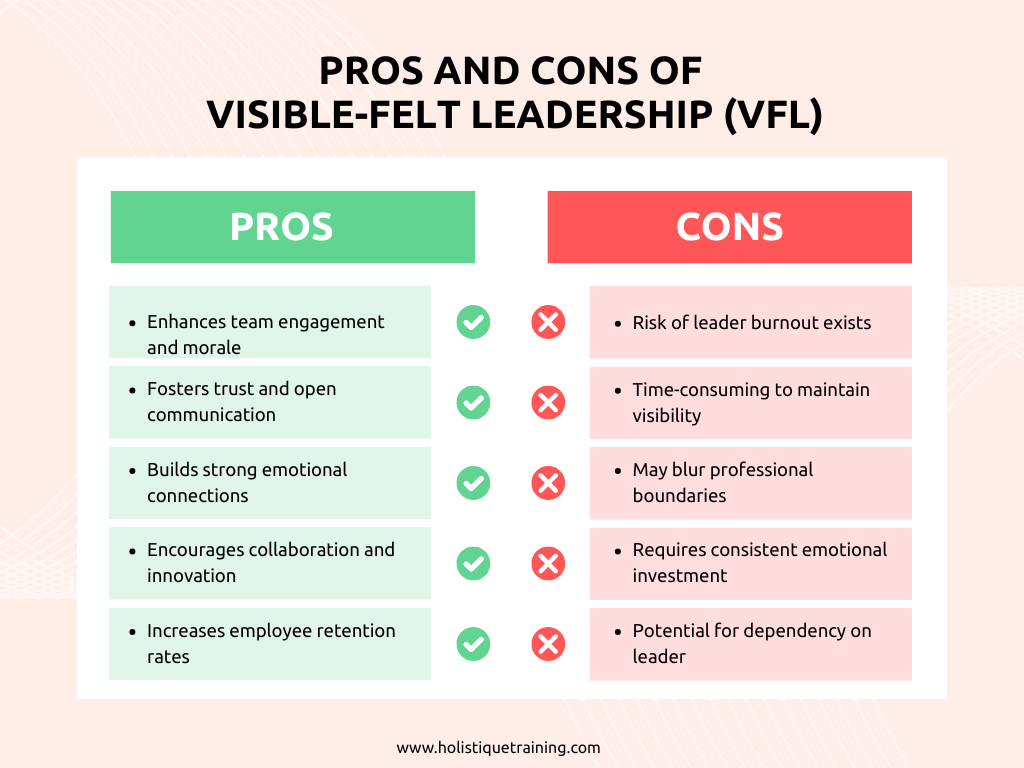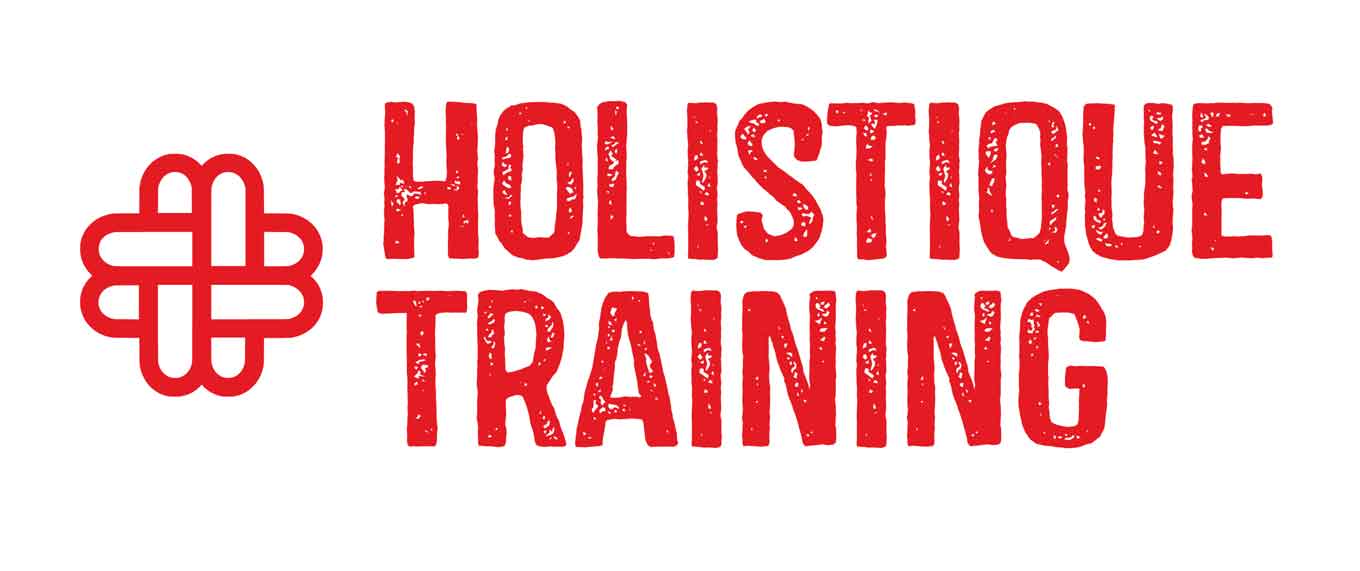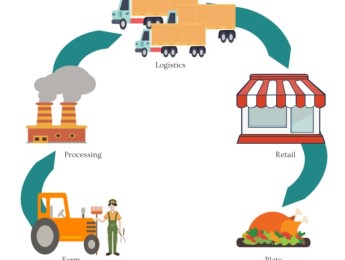- Table of Contents
- Introduction
- What is Visible Felt Leadership (VFL)?
- Key Characteristics of a Visible Felt Leader
- Authenticity:
- Empathy:
- Accessibility:
- Visibility:
- Emotional Intelligence:
- Supportiveness:
- Transparency:
- Recognition:
- Pros and Cons of Visible Felt Leadership
- Pros of VFL
- Cons of VFL
- VFL vs. Other Leadership Styles: What’s the Difference?
- Transformational Leadership
- Servant Leadership
- Autocratic Leadership
- Laissez-Faire Leadership
- Situational Leadership
- Actions You Can Do in the Office as a Visible Felt Leader
- 1- Be Present:
- 2- Practice Active Listening:
- 3- Share Your Story:
- 4- Encourage Feedback:
- 5- Recognize Achievements:
- 6- Be Vulnerable:
- 7- Facilitate Team Bonding:
- 8- Provide Support:
- 9- Communicate Transparently:
- 10- Lead by Example:
- 11- Create a Safe Space for Innovation:
- 12- Invest in Professional Development:
- Conclusion
Introduction
Leadership is an intricate dance of influence, motivation, and connection. Among the myriad styles that have emerged in the modern workplace, one approach stands out for its emphasis on presence, empathy, and active engagement: Visible Felt Leadership (VFL). This blog post delves into the essence of VFL, exploring its characteristics, advantages, challenges, and practical applications in the workplace. By understanding and implementing VFL, leaders can foster an environment of trust, collaboration, and high performance.
What is Visible Felt Leadership (VFL)?
Visible Felt Leadership is a leadership style that prioritizes the leader's presence and emotional connection with their team. Coined to describe a form of leadership where leaders are not only visible but also emotionally available, VFL emphasizes the importance of leaders being physically present and emotionally engaged with their employees. The "visible" aspect refers to leaders being approachable and accessible, while "felt" highlights the emotional resonance they create with their team members.
At its core, VFL is about authenticity and vulnerability. Leaders who practice VFL are open about their thoughts and feelings, allowing their team to see the human side of leadership. This approach fosters a culture of openness, where team members feel valued and understood. By being present and emotionally connected, leaders can inspire trust and loyalty, leading to a more cohesive and motivated workforce.
Key Characteristics of a Visible Felt Leader
Visible Felt Leaders exhibit several defining characteristics that set them apart from traditional leaders. These traits not only enhance their effectiveness but also create a more positive work environment. Here are some key characteristics of a visible felt leader:
Authenticity:
Authenticity is the cornerstone of VFL. These leaders are genuine in their interactions, presenting themselves as they truly are rather than adopting a facade of authority. They share their values, beliefs, and experiences openly, which encourages team members to do the same. This transparency fosters a culture of honesty, where employees feel safe to express their thoughts and concerns. Authentic leaders build trust by aligning their actions with their words, demonstrating integrity in all their dealings.
Empathy:
Empathy is crucial for VFL leaders as it enables them to understand and relate to the feelings and perspectives of their team members. They actively listen and validate the emotions of others, which helps to create a supportive environment. By demonstrating empathy, these leaders can better respond to the needs of their employees, whether it’s providing emotional support during challenging times or celebrating their successes. This emotional attunement not only strengthens relationships but also enhances team cohesion.
Accessibility:
Accessibility refers to the leader’s willingness and ability to be approachable. VFL leaders make a conscious effort to be available for conversations, feedback, and support. They create an open-door policy, encouraging team members to reach out without hesitation. By being physically present in the workplace and engaging in informal interactions, they break down barriers and foster a sense of community. This accessibility allows team members to feel comfortable sharing ideas, seeking guidance, or discussing concerns.
Visibility:
Visibility involves being physically present and actively engaged in the workplace. VFL leaders do not confine themselves to their offices; instead, they participate in team activities, attend meetings, and engage in casual conversations. Their presence reinforces the idea that they are invested in their team’s success. This visibility also allows leaders to observe dynamics within the team, identify potential issues early, and offer support where needed. By being seen, they cultivate a sense of belonging and collective purpose.
Emotional Intelligence:
High emotional intelligence is a defining trait of VFL leaders. They possess the ability to recognize and understand their own emotions as well as those of others. This awareness enables them to navigate complex interpersonal dynamics effectively. VFL leaders use their emotional intelligence to manage stress, resolve conflicts, and inspire positive interactions within the team. By modeling emotional intelligence, they encourage team members to develop their own emotional skills, creating a more harmonious work environment.
Supportiveness:
Supportiveness is a hallmark of VFL. These leaders actively nurture their team members’ growth and development by providing constructive feedback, mentorship, and encouragement. They recognize that each team member has unique strengths and challenges, and they tailor their support accordingly. This can involve offering resources for professional development, facilitating training opportunities, or simply being a reliable source of encouragement during tough times. By fostering a supportive atmosphere, VFL leaders empower their employees to reach their full potential.
Transparency:
VFL leaders prioritize open communication and transparency. They share information about organizational goals, challenges, and changes, fostering a sense of trust and partnership within the team. By keeping team members informed, they help everyone feel involved in the decision-making process. This transparency not only enhances trust but also encourages team members to take ownership of their roles and responsibilities. When employees understand the bigger picture, they are more likely to align their efforts with organizational objectives.
Recognition:
Acknowledging and appreciating the contributions of team members is vital for VFL leaders. Regularly expressing gratitude and recognition boosts morale and motivation, reinforcing a positive work environment. These leaders celebrate both individual and team achievements, ensuring that everyone feels valued for their efforts. Recognition can take many forms, from verbal praise during meetings to formal awards or shout-outs in company communications. By cultivating a culture of recognition, VFL leaders enhance employee engagement and loyalty.
By embodying these characteristics, visible felt leaders create a workplace culture where employees feel seen, heard, and valued. This, in turn, leads to enhanced engagement, productivity, and overall job satisfaction, making VFL a powerful approach to modern leadership.
Pros and Cons of Visible Felt Leadership
Like any leadership style, Visible Felt Leadership comes with its own set of advantages and disadvantages. Understanding these can help organizations assess whether VFL is the right fit for their culture and goals.
Pros of VFL
Enhanced Trust:
One of the most significant advantages of VFL is the heightened level of trust it fosters between leaders and team members.According to research by the Harvard Business Review,75% of employees desire greater authenticity in their workplace. When leaders are authentic and emotionally available, employees feel safe to express their thoughts and concerns. This trust creates a foundation for open communication, allowing for honest discussions about challenges, feedback, and ideas. As trust builds, team members are more likely to collaborate effectively and support one another, leading to a stronger, more cohesive team.
Increased Engagement:
VFL cultivates a sense of belonging and purpose among team members. When employees perceive their leaders as approachable and invested in theirwell-being, they are more likely to engage fully in their work. This emotional connection enhances motivation and commitment, resulting in higher levels of productivity and job satisfaction. Engaged employees are more likely to go above and beyond in their roles, contributing positively to the organization’s overall success.
Improved Communication:
Open lines of communication are a hallmark of VFL. Leaders who practice this style encourage dialogue, actively seeking input from their team members. By fostering an environment where everyone feels comfortable sharing their ideas and concerns, VFL leaders facilitate better collaboration and problem-solving. This transparent communication helps to prevent misunderstandings and conflicts, leading to a more harmonious workplace. Also,almost70% of employees believe that improved communication in the workplace would enhance their productivity.
Stronger Relationships:
The emphasis on empathy and support inherent in VFL builds strong relationships within teams. Employees who feel connected to their leaders and colleagues are more likely to collaborate effectively and support one another. These strong interpersonal relationships contribute to a positive team culture, where individuals feel valued and respected. As relationships strengthen, team dynamics improve, leading to enhanced cooperation and shared goals.
Higher Retention Rates:
Organizations that embrace VFL often experience lower turnover rates. Employees are more likely to stay with a company where they feel valued, understood, and emotionally connected to their leaders. On the contrary,66%of employees indicate they would resign from their job if they felt unappreciated. This stability not only saves organizations the costs associated with hiring andtraining new employees but also ensures continuity and consistency within teams. Long-term employees tend to develop deeper expertise and commitment to the organization, further enhancing its success.
Resilience in Challenges:

VFL leaders can help teams navigate challenges more effectively. Their emotional support and presence can bolster team morale during difficult times. When employees feel supported by their leaders, they are better equipped to handle stress and adversity. This resilience can lead to innovativeproblem-solving and a proactive approach to overcoming obstacles, ultimately contributing to the organization’s success.
Cons of VFL
Potential for Burnout:
The emotional demands of VFL can lead to burnout for leaders who may feel overwhelmed by the need to be constantly present and emotionally available. The pressure to maintain high levels of engagement and support can take a toll on a leader’s well-being. If leaders do not establish boundaries and practice self-care, they risk compromising their effectiveness and overall job satisfaction.
Boundary Issues:
The close relationships fostered by VFL can blur professional boundaries. While emotional connection is essential, leaders must be mindful of maintaining a balance between approachability and authority. Over-familiarity with team members can lead to challenges indecision-making and conflict resolution. Leaders must navigate these dynamics carefully to ensure that relationships remain professional and productive.
Overemphasis on Emotion:
While emotional connection is vital, an overemphasis on feelings can sometimes hinder objective decision-making. Leaders may find themselves prioritizing emotional considerations over rational analysis, which can lead to suboptimal outcomes. Striking a balance between emotional awareness and logical reasoning is essential for effective leadership. Leaders must be able to make tough decisions while still being empathetic to their team members’ feelings.
Inconsistency:
Not all team members may respond positively to VFL. Some individuals may prefer a more traditional, authoritative leadership style, leading to potential conflicts in expectations. Leaders who practice VFL must be attuned to the diverse preferences and needs of their team members. This requires flexibility and adaptability in their approach, as well as the ability to recognize when to shift styles to accommodate different personalities.
Time-Intensive:
Building relationships and fostering emotional connections takes time. Leaders may need to invest significant effort to practice VFL effectively. This time commitment can be challenging, especially in fast-paced environments where immediate results are often prioritized. Leaders must balance their responsibilities and find ways to integrate VFL practices into their daily routines without sacrificing productivity.
Resistance to Change:
Organizations accustomed to traditional leadership styles may resist the shift to VFL. Employees and leaders alike may be hesitant to embrace this new approach, particularly if they are unfamiliar with its principles. Change management strategies may be necessary to facilitate this transition, including training, workshops, and ongoing support. Leaders must be prepared to address concerns and demonstrate the benefits of VFL to encourage buy-in from their teams.
In summary, while Visible Felt Leadership offers numerous benefits that can enhance team dynamics and organizational culture, it also presents challenges that leaders must navigate. By understanding these pros and cons, organizations can make informed decisions about integrating VFL into their leadership practices and creating a more engaged and resilient workforce.
VFL vs. Other Leadership Styles: What’s the Difference?
Visible Felt Leadership stands apart from other leadership styles due to its unique focus on emotional connection and presence. Here’s how VFL compares to some other common leadership styles:
Transformational Leadership
Transformational leaders inspire and motivate their teams through a shared vision and enthusiasm. While they also prioritize emotional connection, VFL places a stronger emphasis on the leader's visibility and emotional availability. Transformational leaders may focus more on inspiring change, while VFL leaders concentrate on fostering relationships and emotional support within their teams.
Servant Leadership
Servant leaders prioritize the needs of their team members, aiming to serve rather than command. While both VFL and servant leadership emphasize empathy and support, VFL leaders are more visible and engaged in day-to-day operations.Servant leadership may focus more on empowering team members to take the lead, while VFL leaders actively participate in the team’s activities.
Autocratic Leadership
Autocratic leaders make decisions unilaterally, often relying on authority and control. This style contrasts sharply with VFL, which values openness, collaboration, and emotional connection. VFL leaders encourage input and participation from their teams, fostering a sense of belonging and engagement.
Leadership Style | Key Focus | Approach to Team Engagement | Decision-Making Style |
Visible Felt Leadership (VFL) | Emotional connection and presence | High engagement and support | Collaborative and inclusive |
Transactional Leadership | Task completion and performance | Limited engagement, focused on results | Directive and structured |
Transformational Leadership | Inspiring and motivating teams | High engagement, encourages growth | Visionary and consensus-driven |
Servant Leadership | Serving team needs | High engagement, prioritizes team well-being | Facilitative and supportive |
Autocratic Leadership | Authority and control | Low engagement, limited input from team | Centralized and directive |
Democratic Leadership | Team participation in decisions | High engagement, values input | Collaborative and consensus-based |
Laissez-Faire Leadership | Autonomy and independence | Low engagement, hands-off approach | Minimal intervention |
Laissez-Faire Leadership
Laissez-faire leaders take a hands-off approach, allowing team members to make decisions independently. While this style can promote autonomy, it lacks the emotional engagement and support characteristic of VFL. VFL leaders provide guidance and support while remaining actively involved in their teams' activities.
Situational Leadership
Situational leaders adapt their style based on the needs of their team and the context. While VFL can be considered a situational approach, it specifically emphasizes emotional connection and visibility as core components. Situational leaders may shift their style based on circumstances, while VFL leaders consistently prioritize presence and emotional engagement.
In summary, Visible Felt Leadership distinguishes itself through its focus on emotional connection, visibility, and authenticity. By understanding these differences, leaders can choose the style that best aligns with their organizational goals and team dynamics.
Actions You Can Do in the Office as a Visible Felt Leader
Implementing Visible Felt Leadership (VFL) in the workplace requires intentional actions and behaviors that reinforce emotional connection and presence. Here are several practical steps that leaders can take to embody VFL effectively, fostering a more engaged and supportive work environment:
1- Be Present:
Make a conscious effort to be physically present in the workplace. This means not only being available in your office but also actively participating in team activities, walking through common areas, and engaging in casual conversations with team members. Attend team meetings and encourage informal gatherings, such as coffee breaks or lunch outings, where you can connect with employees on a personal level. Your presence shows that you value your team and are invested in their experiences.
2- Practice Active Listening:
When team members speak, give them your full attention. This involves not just hearing their words but also understanding their emotions and perspectives. Use verbal and non-verbal cues to demonstrate that you are engaged—maintain eye contact, nod in agreement, and ask follow-up questions. By practicing active listening, you validate their feelings and make them feel heard. This practice fosters trust and encourages open communication, allowing team members to share their thoughts and concerns more freely.
3- Share Your Story:
Open up about your experiences, challenges, and triumphs. Sharing your personal journey—whether it’s a professional setback you overcame or a lesson you learned—can help team members relate to you and feel more connected. This vulnerability humanizes you as a leader and encourages others to share their own stories. When employees see that their leader has faced challenges and grown from them, they may feel more comfortable discussing their struggles and seeking support.
4- Encourage Feedback:
Create an environment where team members feel comfortable providing feedback. Regularly solicit input on your leadership style, team dynamics, and organizational processes. This can be done through informal check-ins, anonymous surveys, or structured feedback sessions. Actively seek out diverse perspectives and demonstrate that you value their opinions. When employees see that their feedback leads to positive changes, it reinforces their sense of ownership and engagement within the team.
5- Recognize Achievements:
Acknowledge and celebrate both individual and team accomplishments regularly. This recognition can take many forms, from verbal praise during meetings to formal awards or shout-outs in company communications. Highlighting successes not only boosts morale but also reinforces a culture of appreciation. Make it a point to recognize efforts, big and small, and encourage team members to celebrate each other’s achievements. This practice fosters a positive atmosphere and motivates everyone to contribute their best.
6- Be Vulnerable:
Don’t be afraid to show your emotions and admit when you don’t have all the answers. Vulnerability can foster deeper connections and trust within your team. Share your challenges and uncertainties, and invite team members to collaborate on finding solutions. When leaders model vulnerability, it creates a safe space for employees to express their own concerns and seek help, leading to a more supportive team culture.
7- Facilitate Team Bonding:
Organize team-building activities that encourage relationship-building and collaboration. These can range from informal gatherings, such as potlucks or team outings, to structured workshops focused on communication and teamwork. Encourage participation and ensure that activities cater to diverse interests and preferences. By facilitating opportunities for team bonding, you create a sense of community and belonging, which is essential for fostering a positive work environment.
8- Provide Support:
Be proactive in offering assistance to team members facing challenges. Whether it’s providing resources for professional development, helping them navigate personal issues, or simply being a listening ear, your support can make a significant difference. Show empathy and understanding when team members encounter obstacles, and offer guidance and encouragement. This support reinforces the idea that you are invested in their success and well-being.
Table: Key Performance Indicators (KPIs) of Visible-Felt Leadership
KPI | Description |
Employee Engagement Score | Measures overall employee satisfaction and involvement |
Team Collaboration Rate | Assesses the frequency and quality of collaborative efforts |
Trust and Transparency Index | Evaluates the level of trust and openness within the team |
Retention Rate | Tracks the percentage of employees remaining in the organization |
Feedback Response Rate | Measures the responsiveness to feedback requests and suggestions |
9- Communicate Transparently:
Share information about organizational changes, goals, and challenges openly with your team. Transparency fosters trust and keeps team members informed about the bigger picture. Regularly update your team on developments and encourage questions and discussions. When employees understand the context behind decisions and changes, they are more likely to feel involved and committed to the organization's goals.
10- Lead by Example:
Model the behaviors you wish to see in your team. Demonstrate empathy, support, and engagement in your interactions. If you want team members to communicate openly, show them how by being transparent and approachable. If collaboration is a priority, actively seek input from others and involve them in decision-making processes. Leading by example sets the tone for the team and encourages employees to adopt similar behaviors.
11- Create a Safe Space for Innovation:
Foster an environment where team members feel safe to share their ideas and take risks without fear of judgment. Encourage brainstorming sessions and open discussions where creativity can flourish. Emphasize that mistakes are part of the learning process, and celebrate innovative thinking. When employees feel secure in expressing their ideas, it enhances collaboration and drives innovation within the team.
12- Invest in Professional Development:
Show commitment to your team’s growth by providing opportunities for professional development. This can include training programs, workshops, mentorship, or access to resources that enhance their skills. Encourage team members to pursue their career goals and support them in their endeavors. Investing in their development not only enhances their capabilities but also demonstrates your commitment to their success.
By incorporating these actions into your leadership approach, you can cultivate a culture of Visible Felt Leadership that enhances team dynamics and drives success. The result is a workplace where employees feel valued, supported, and motivated to contribute their best efforts, ultimately leading to a more engaged and high-performing organization.
Conclusion
Visible Felt Leadership represents a transformative approach to leadership, emphasizing the importance of emotional connection, authenticity, and presence. By embodying the characteristics of a visible felt leader, individuals can foster trust, engagement, and collaboration within their teams. While VFL comes with its own set of challenges, the benefits it brings to organizational culture and employee satisfaction are undeniable.
As workplaces continue to evolve, leaders who embrace VFL will be better equipped to navigate the complexities of modern leadership. By prioritizing emotional connection and visibility, leaders can create an environment where team members feel valued, supported, and motivated to contribute their best efforts. In doing so, they pave the way for a more engaged, resilient, and successful workforce.

























